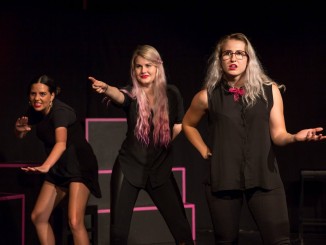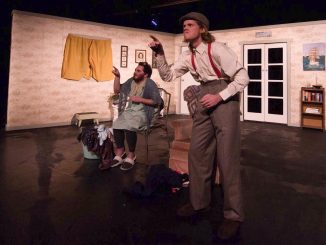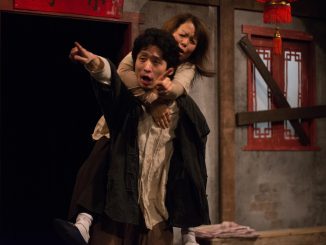
AIGA is an emotive and visually spectacular devised performance piece, which deals with themes of interaction and desire as a Pasifika woman with disabilities.
The performance piece consists of biographical vignettes made up of singing, dancing, poetry, and acted scenes. The main performer and subject of the piece, Lusi Faiva, was diagnosed with cerebral palsy at the age of two. The story is incredibly moving, filled with heartbreaking depictions of abandonment, rejection, and bullying; and with heartwarming accounts of singing with friends, foster parents providing language, and high-energy music videos. The interconnected scenes provide a full and rich tapestry and, like all the best tapestries, the order of the pieces creates art which is greater than the sum of its parts.
The creatives have gone to great lengths to put on a show that is extremely accessible. 30 minutes before the show opens, the audience are invited to participate in a touch tour, where the set, props, and costume are proffered for tactile examination. The audience are then invited into the performance space. The traverse staging and use of tiered seating allows for good sightlines, while leaving room for audience members who may not be able to navigate the stairs. There were also bean bags available for the audience to sit on. Before the show commences, the director, Moana Ete, starts a live audio description that keeps up the entire show. There is also a New Zealand Sign Language interpreter, who translates the show live. There will also be a relaxed show, where the loud noises and the bright lights are levelled out. Far from detracting, or distracting, from the piece at large, these added features help to elevate the piece and ensure that all audience members are able to extract meaning and engage with the piece. It is incredible to see such a performance of meaning, and the normalisation of accessibility in the arts. The creative team does a remarkable job of incorporating these elements, and making this accessibility feel inherent to the show.
The set is used to great effect, as a medium for accessibility and storytelling. One ‘end’ of the traverse stage has an obtuse (from the audience’s viewpoint) ‘V’ made of semi-transparent vinyl. The other ‘end’ has three semi-transparent panels that are shifted around throughout the performance, as needed. The primary purpose of these two ‘end pieces’ is for the projection of subtitles. The panels at each end are angled in such a way that the audience can always see the subtitles. This provides an extra facet of accessibility, as the subtitles exclusively depict Lusi Faiva’s speech, and poetry; and the New Zealand Sign Language interpreter translates the other performers’/audio describer’s speech.
The set, props and costume are visually cohesive and spectacular. The main space of the stage is delineated by a brown oval, resembling a fale. The main props are different-sized wooden boxes. The costumes are constructed from individually-styled black fabrics, over which craft paper accents are added to evoke different roles and characters. The uniform colouring and finish to the props, costume and set, creates a unified visual component that helps link the sections of the play. The craft paper costume pieces, which consist of masks, skirts, and flowers, are intricate and finely-detailed. They are larger than life, and do a great job of intimating the temperament of the character. Another visually striking element of the play is the use of projection. This includes the subtitles, but is also used to show scenery. A particularly impressive piece of projection shows a man running, while the screens are moved. This creates urgency, and the impression that the man is physically approaching. This is a beautiful coupling of design and choreography. Rowan Pierce, the spatial and audio/visual designer, should be commended on such a dynamic design. Michael Goodwin, the operator, also deserves praise for his seamless execution of a tech-heavy show.
The performances are extraordinary, and use a broad array of media to convey meaning. The performers interchangeably sing, dance, use spoken-word poetry, shadow-mime and act out scenes, to great effect. The mixing of these media is best utilised when the performers are either in opposition to one another, or in chorus with one another. A particularly poignant point of opposition is Lusi Faiva facing the shadow of Iana Grace, as a barista, and getting skipped in the line. There were some fantastic moments of choral dancing, including the waltz to Engelbert Humperdinck, the haute couture ball, and the hip-hop dance video. These dances not only included Lusi Faiva’s wheelchair, but made the wheelchair intrinsic to the choreography. Forest V Kapo has a number of solo dances, which mesmerise and entertain. Iana Grace has an amazing sequence in which they play a film director and their live feed is projected out to the audience. This must be technically complex, but was handled with poise. Fiona Collins shines in the mask work, and the physicalising of the other-worldly. Lusi Faiva has two moments that have stuck, when she was leading the performers in singing a song, and, with wheelchair and fists raised to the heavens, Lusi Faiva cries out in performance of the warrior she is. Both of these moments are extremely powerful and typify the exploration of desire and identity that permeate the piece.
The play delivers an important message, that someone can have a disability, but this does not describe the entirety of their life. That is not to say that disability should be ignored, but rather the person should be seen and acknowledged. That people with disabilities have desire, hope, strength, and courage. In short, people with disabilities are people, first. It is vital that art which centres people with disabilities, and art that has accessibility so that baked-in, is normalised and abundant. It is particularly important that these stories be told now as, at the time of writing, the current government has announced immediate changes which would narrow the scope of disability support services and what funding can be used for. As it stands, the speech-to-text function that Lusi Faiva uses, struggles to incorporate nuances in dialect and ‘mother tongue’, it hardly seems the time to be rolling things back…
AIGA is a thought-provoking, and extremely necessary piece. The story is emotive and thoughtfully-constructed. The set/lighting/sound configuration is a true marvel, consisting of many complex elements. The rigorous adhesion to accessible practices is a shining example for every production to come, and means no one is left behind.
AIGA plays at Te Pou Theatre from Wednesday 20th to Sunday 24th of March 2024.




Leave a Reply